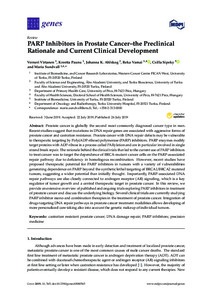PARP Inhibitors in Prostate Cancer-the Preclinical Rationale and Current Clinical Development
Verneri Virtanen; Reka Varnai; Csilla Sipeky; Kreetta Paunu; Johanna K. Ahlskog; Maria Sundvall
PARP Inhibitors in Prostate Cancer-the Preclinical Rationale and Current Clinical Development
Verneri Virtanen
Reka Varnai
Csilla Sipeky
Kreetta Paunu
Johanna K. Ahlskog
Maria Sundvall
MDPI
Julkaisun pysyvä osoite on:
https://urn.fi/URN:NBN:fi-fe2021042822678
https://urn.fi/URN:NBN:fi-fe2021042822678
Tiivistelmä
Prostate cancer is globally the second most commonly diagnosed cancer type in men. Recent studies suggest that mutations in DNA repair genes are associated with aggressive forms of prostate cancer and castration resistance. Prostate cancer with DNA repair defects may be vulnerable to therapeutic targeting by Poly(ADP-ribose) polymerase (PARP) inhibitors. PARP enzymes modify target proteins with ADP-ribose in a process called PARylation and are in particular involved in single strand break repair. The rationale behind the clinical trials that led to the current use of PARP inhibitors to treat cancer was to target the dependence of BRCA-mutant cancer cells on the PARP-associated repair pathway due to deficiency in homologous recombination. However, recent studies have proposed therapeutic potential for PARP inhibitors in tumors with a variety of vulnerabilities generating dependence on PARP beyond the synthetic lethal targeting of BRCA1/BRCA2 mutated tumors, suggesting a wider potential than initially thought. Importantly, PARP-associated DNA repair pathways are also closely connected to androgen receptor (AR) signaling, which is a key regulator of tumor growth and a central therapeutic target in prostate cancer. In this review, we provide an extensive overview of published and ongoing trials exploring PARP inhibitors in treatment of prostate cancer and discuss the underlying biology. Several clinical trials are currently studying PARP inhibitor mono-and combination therapies in the treatment of prostate cancer. Integration of drugs targeting DNA repair pathways in prostate cancer treatment modalities allows developing of more personalized care taking also into account the genetic makeup of individual tumors.
Kokoelmat
- Rinnakkaistallenteet [19207]
